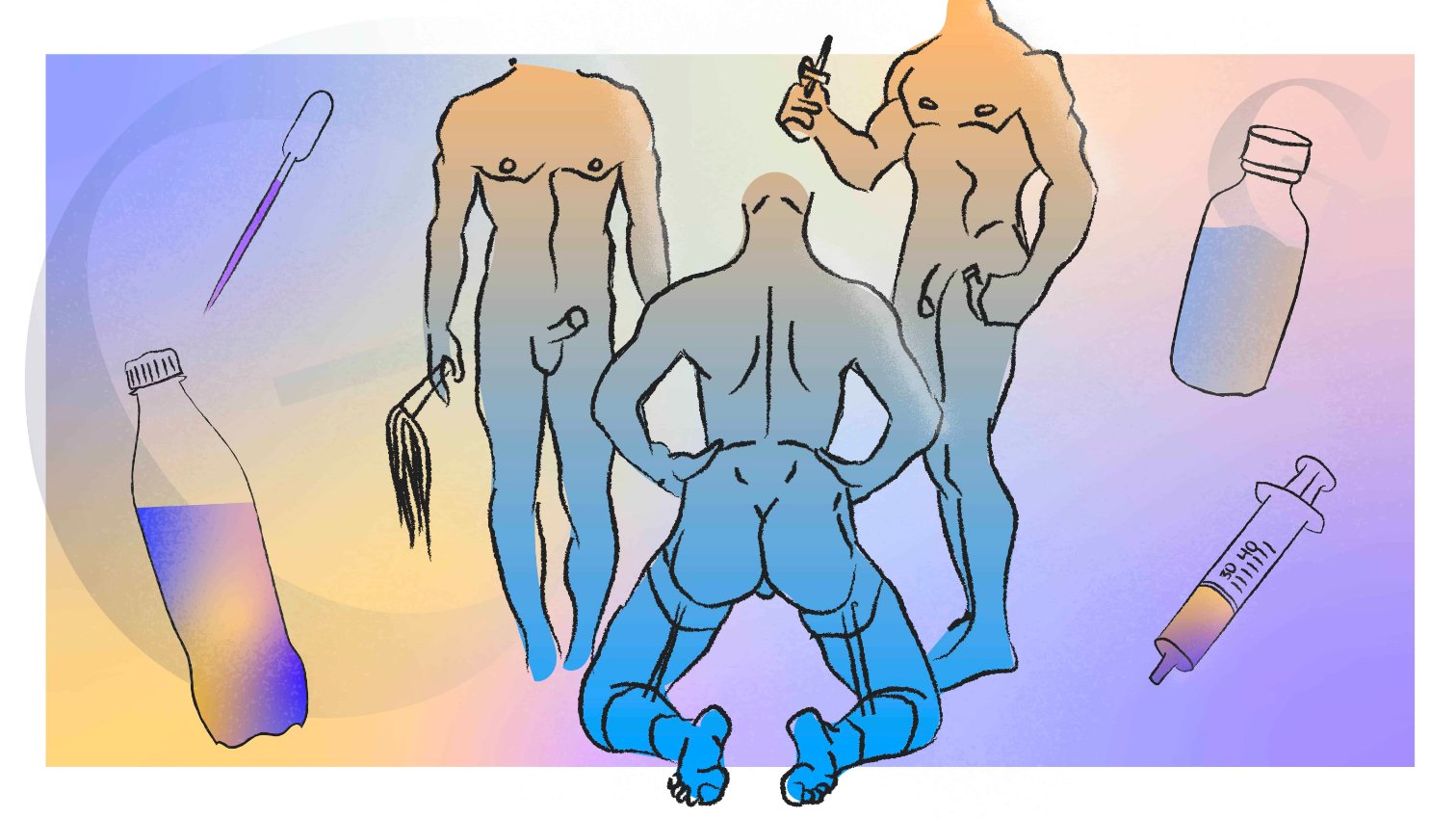
Quick Facts 
GHB/GBL is also commonly referred to as “G”. The drug increases sexual desire and has a relaxing effect, making it popular in chemsex. Emojis like 🍼🥤💧 on hookup apps can indicate an interest in using GHB in sexual contexts.
⬇️ GHB/GBL is a depressant (also known as ‘downers’)
🔴 The risk of overdose is high, with fatal overdoses mainly occurring when GHB is mixed with other drugs, especially central nervous system depressants such as alcohol, benzodiazepines, or opioids.
A lot of people who use methamphetamine in sexual contexts can do so in a controlled way. It’s important to be aware of potential harmful consequences and know how to avoid them.
What is it?
GHB and GBL are commonly referred to as G, and are abbreviations for gamma-hydroxybutyric acid and gamma-butyrolactone. GHB/GBL is a neurotransmitter that affects body functions such as movement, mood, sleep, and cognition.
What is the difference between GHB and GBL?
GHB is classified as a controlled substance and was initially used in medicine as an anesthetic. GBL is a corrosive liquid used as a solvent and cleaning agent. The effects of GHB and GBL are similar but differ slightly. GHB is the substance produced in the body when GBL is ingested. GBL has a stronger effect than GHB, but the high lasts shorter.
What does it look like?
GBL is a clear, odorless liquid with a salty taste, and is slightly viscous. If the manufacturing process fails, the liquid can have a pungent smell and sharp taste. The substance is often stored in empty PET bottles (such as soda bottles) and dosed with pipettes or syringes. GHB is an odorless and tasteless white powder; homemade GHB is a water solution.
How is it used?
G is corrosive and must be taken in a very diluted form. G is dosed to the milliliter (1:100 ml) and then diluted in a non-alcoholic liquid using a pipette or syringe (without a needle). For every 1 ml of the concentrated substance (G), add 100 parts of a non-alcoholic liquid. The mixture is then swallowed in one gulp. For a more gradual effect, the dose can be added to an entire non-alcoholic drink and consumed over a short period.
Body weight, physical condition, and tolerance influence dosing. If you have low body weight, take G on an empty stomach, or feel physically exhausted, it is safer to take lower doses. Higher doses are often used by people who have already developed a tolerance to G.
Dosage can vary from 0.8-1.2 ml GBL or 1-2 ml GHB.
💥 Since G is produced illegally, it is difficult to know the concentration of the substance, so it is good to start with half a dose and wait for the effect before taking more.
💥 Sometimes G is dosed directly from the pipette or syringe into the mouth after taking a large gulp of liquid (without swallowing it). When G is diluted directly in the mouth, there is a risk of burns on the lips, tooth enamel, and throat because the substance is corrosive.
💥 Never inject GHB/GBL (slamming), as the risk of overdose/poisoning and burns on the veins is high.
How does it feel?
The effect varies from person to person, depending on how G is taken, how the drug is composed, dose, and other factors. Initially, the effect is stimulating, but with increased use and dose, the effect becomes more sedative/relaxing.


The high from G can be compared to alcohol but with a shorter duration, greater sexual stimulation, and mental clarity. When taking G, one may feel:
- Euphoric, happy, joyful
- Calm, less anxious
- More social and talkative
- Heightened sensory perceptions
- Sexually aroused, horny, others appear more attractive
- Inhibited
GHB/GBL and sex
G is one of the most common drugs used in chemsex because it has a sexually stimulating and inhibiting effect. G also has a relaxing effect that makes receptive sex (bottoming) easier and more enjoyable. Since G has a sexually disinhibiting effect, users may take more risks during sex.
Safer sex with GHB/GBL:
- G can make it harder to climax (orgasm). If using condoms, remember to change them after 30 minutes as condoms wear out with prolonged use.
- Because G has a relaxing effect, it is harder to feel if you or someone else is getting hurt during sexual activities such as penetration, fisting, or using dildos or plugs. The anal mucosa is thin and delicate, making it easier for small tears or fissures to occur during sex, increasing the risk of transmission of hiv, hepatitis and other sexually transmitted infections (STI)
- Talk to your partner(s) about consent, preferences and boundaries and bring the things you need like condoms, lube, gloves, and things to clean toys with (like plugs and dildos)
Side effects and long-term consequences
G affects the central nervous system, including the part responsible for breathing. A high dose can cause life-threatening respiratory paralysis. High doses also affect memory during use, leading to memory lapses.
Frequent use of high doses can lead to depression, anxiety, and sleep disturbances.
Withdrawal symptoms occur 2 to 3 hours after the last dose and can last up to 12 hours. Symptoms experienced during withdrawal can include:
- Anxiety
- Seizures
- Insomnia
- Vomiting
- High blood pressure
- Increased heart rate
- Confusion
- Hallucinations
In severe cases, hyperactivity, paranoia, psychosis, seizures, and death have been reported.
Long-term consumption of G can damage the liver and kidneys, and prolonged use can cause memory difficulties.
Managing an overdose


Initial signs of overdose may include:
- Nausea
- Vomiting
- Dizziness
- Yawning
- Difficulty speaking
- Involuntary movements or sounds
- Sudden fear
Signs of severe overdose may include:
- Muscle twitching
- Loss of bowel and bladder control (involuntary defecation/urination)
- Sudden sleepiness
- Coma, also known as deep unconsciousness, where the brain’s control over the body is largely impaired. Unlike deep sleep, a person in a coma cannot be awakened.
- A high overdose can lead to loss of ability to breathe, which is life-threatening.
Always take signs of overdose very seriously. If an overdose is suspected, it is important to:
- Call for an ambulance: Dial 112, Sweden’s emergency number, which also works in all EU countries. Inform them that you suspect an overdose and describe the symptoms as accurately as possible. It’s crucial to be honest about what and how much the person has taken, as this helps medical staff provide the right care quickly
- Keep the person awake and calm: If possible, try to keep the person awake and calm. Ensure they are breathing and keep their airways clear. Sit or lay them in a comfortable position. If they are unconscious, place them in the recovery position to keep the airways clear and reduce the risk of choking
- Keep the person cool: Ensure the person is in a cool environment; you can open windows, doors, or turn on a fan. Use cool, damp towels on areas where major blood vessels are close to the skin, such as the neck, forehead, armpits, and groin. Offer water in small amounts. Avoid using extremely cold water or ice directly on the skin, as this can worsen the condition
- In case of seizures: Protect the person from injury during the seizure, but do not hold them down. Place something soft under their head, ensuring it doesn’t obstruct their breathing. After the seizure, lay the person on their side with their head slightly tilted back (this helps with breathing and allows saliva to drain from the mouth)
- Stay with the person: Regularly check their breathing and pulse. If breathing becomes irregular or stops, or if the pulse is weak or cannot be felt, you may need to perform CPR. If you’re unsure how to do this, follow the instructions from the emergency operator (112)
🔗 Addiction Risk
Regular use of G leads to rapid tolerance development (you need more of the substance to achieve the same effect).
Long-term use over several days or weeks leads to physical dependence. Physical dependence can occur quickly, even after using it for just three consecutive days.

GHB/GBL and other drugs
- Avoid combining G with alcohol, poppers, ketamine, opiates, benzodiazepines, and sleeping pills, as these enhance the depressant effects of G.
- The effect of G can be dampened when combined with amphetamine, ecstasy, mephedrone, crystal meth, and cocaine. The risk of overdose increases due to taking too much or too quickly.
- Combining G and Viagra causes a significant drop in blood pressure, potentially leading to life-threatening cardiovascular failure.
GHB/GBL and medications
- Using allergy medications at the same time as using G can cause circulatory problems and induce a coma.
- Medications to treat epilepsy (such as valproate, topiramate, etc.) combined with GHB/GBL can lead to life-threatening interactions as these medications inhibit the breakdown of GHB in the body, resulting in higher and potentially dangerous levels of GHB in the blood.
GHB/GBL and HIV- treatment (ART)
GHB/GBL and HIV medications are metabolized by the same enzyme system (CYP450) in the liver, leading to interactions between the substances.
Since GHB/GBL and some NNRTI medications are metabolized in the liver, concurrent use can increase liver stress. GHB/GBL rarely causes liver toxicity with recreational use, but it’s essential to be aware of the potential risk.
Protease inhibitors (PI) used to treat HIV, such as darunavir, atazanavir, and etravirine, can cause lethal concentrations of GHB/GBL in the body, even at low doses of the substance.
Drug use can sometimes make it harder for people to adhere to their treatment plan, as it is easy to lose track of time and forget to take HIV medication. Inconsistent medication intake can lead to poor virological control.
🕐 Always have your HIV medications with you. If you often forget to take your medication, set an alarm or reminder on your phone. Take substances and HIV medications at different times to reduce the risk of side effects. Always take low doses of substances when you are taking medications simultaneously.
🗣️ Talk to your doctor or an expert about interactions between HIV medication and GHB/GBL.
Harm reduction
- Always measure your own dose yourself using a pipette/dosing syringe, which can be purchased at most pharmacies.
- If you make a mistake while dosing (for example, if you forget how much G you have poured into a drink), pour it out and start over.
- Subsequent doses must be much smaller than the initial dose, as G is still active in the body even after the high has worn off and several hours have passed between doses. It is better to take small amounts.
- Keep track of the time
of your last dose and adjust the subsequent amount accordingly. For example, you can take a screenshot on your phone showing the time, start a stopwatch, or write your dose somewhere you can easily find the note again.
- Never inject GHB/GBL, and never dose directly into the mouth. Do not combine G with substances that have a sedative or numbing effect (alcohol, ketamine, benzodiazepines, opiates, sleeping pills).
- Never leave a person who has taken too much alone, and never take G alone, as unexpected side effects can occur. Inform others that you have taken G.
- Be alert to whether you or someone else feels unwell and needs help, for example, if someone has taken too much or you perceive that an assault is taking place.
If you or someone else has experienced assault, there is help available. If you have experienced something you do not feel comfortable with you can find out where to turn for support in the article support and connections


